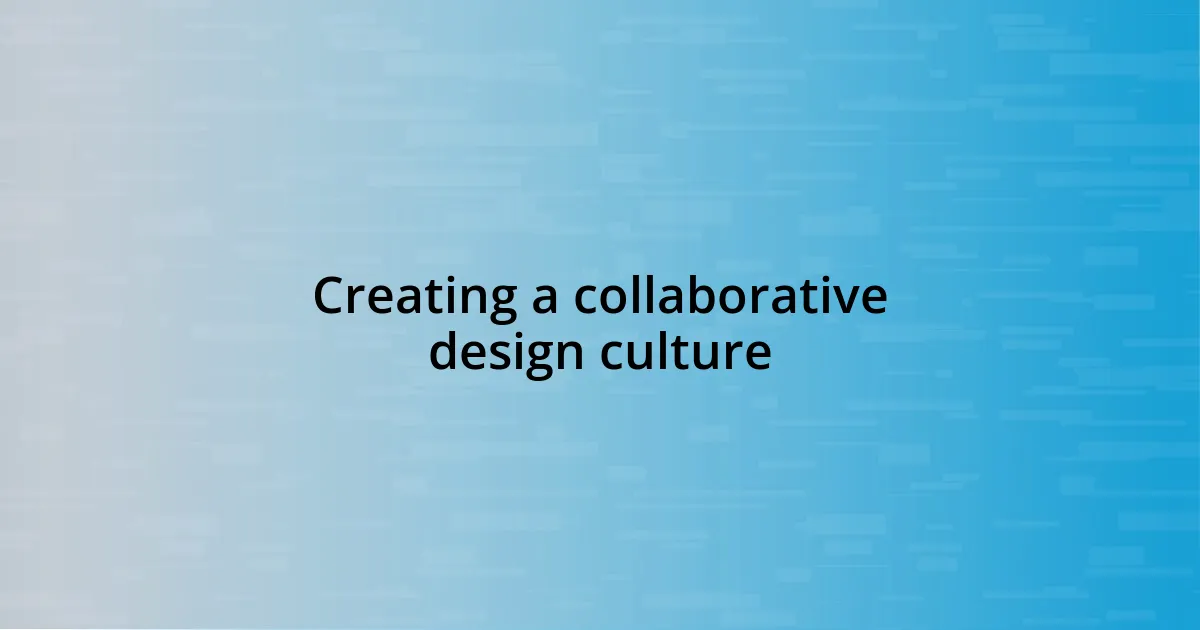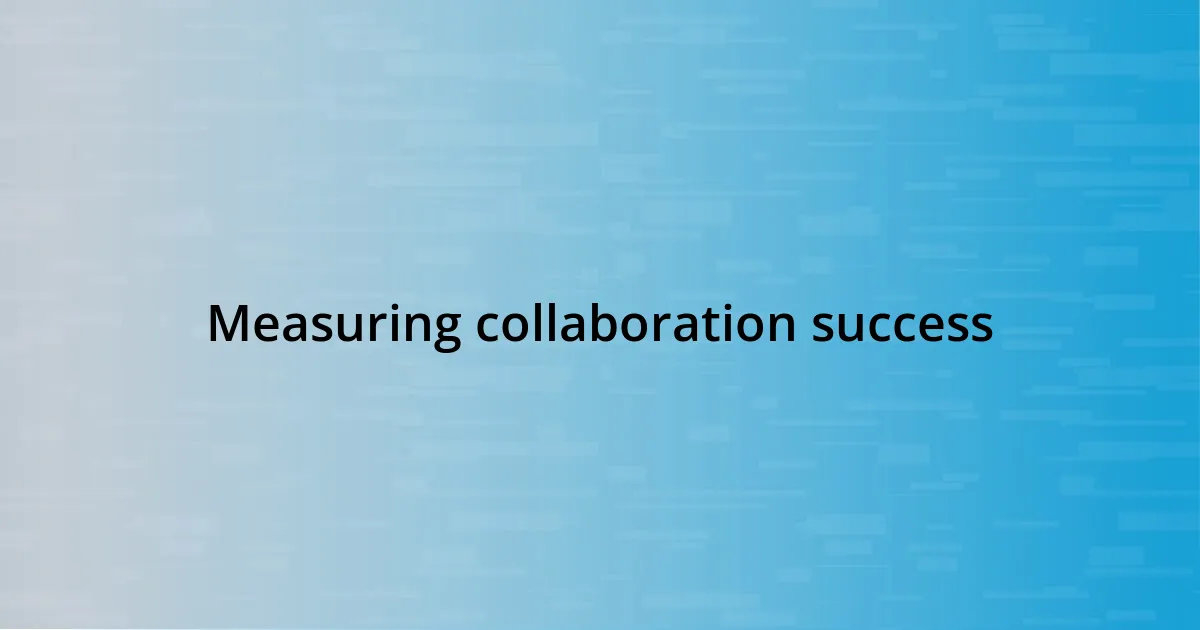Key takeaways:
- Design collaboration blends diverse perspectives, enhancing creativity and fostering strong team relationships.
- Clear communication channels, like weekly check-ins and visual tools, streamline discussions and improve team cohesion.
- Choosing the right collaboration tools based on project needs boosts efficiency and encourages real-time feedback.
- Creating a culture of trust and open feedback, alongside celebrating small wins, significantly improves team morale and innovative output.

Understanding design collaboration benefits
One of the most significant benefits of design collaboration is the infusion of diverse perspectives, which can lead to more innovative solutions. I remember a project where my team included members from different backgrounds—developers, marketers, and even customer support. This mix allowed us to tackle a problem from multiple angles, resulting in a design that not only met technical specifications but also resonated deeply with our users.
Collaboration also fosters a sense of community and belonging among team members, which can be incredibly motivating. I’ve experienced first-hand how brainstorming sessions transform the mood of a project. Picture this: we’re all gathered around a table, exchanging ideas energetically, and I can see the enthusiasm in my colleagues’ faces. That energy doesn’t just fuel creativity; it builds relationships that can last beyond the project itself.
Ultimately, effective design collaboration enhances the quality of the work produced. When I reflect on projects where I collaborated closely with others, I can’t help but feel a sense of pride seeing our combined efforts create something truly unique. Isn’t it fascinating how working together can elevate our designs to a level we might not achieve alone?

Establishing clear communication channels
Establishing clear communication channels is vital in any design collaboration. From my experience, a well-defined communication strategy minimizes misunderstandings and ensures that everyone is on the same page. I’ve found that using dedicated channels for specific topics—like project updates, feedback, or brainstorming—helps streamline discussions and reduce noise, making it easier to focus on what truly matters.
One project stands out in my memory where we implemented regular check-ins via a messaging app. The simple act of having a dedicated time each week to share updates and concerns created an open environment for feedback. It wasn’t just about the tasks; it was about listening to each other and making sure everyone felt valued. I noticed this approach led to quicker problem-solving and a more cohesive team spirit.
Additionally, utilizing visual tools such as design boards or collaborative platforms can enhance this communication further. I once introduced a shared online board where team members could leave comments on design iterations in real-time. This visual representation sparked lively discussions and allowed us to capture feedback organically. It’s exhilarating to see how clear communication transforms collaboration, turning what can initially feel like a series of individual efforts into a united creative endeavor.
| Communication Method | Benefits |
|---|---|
| Weekly Check-ins | Fosters open dialogue and timely feedback |
| Dedicated Channels | Reduces misunderstandings and enhances focus |
| Visual Tools | Encourages real-time collaboration and creativity |

Choosing the right collaboration tools
Choosing the right collaboration tools is crucial for a successful design process. In my experience, different projects benefit from different tools based on team dynamics and goals. For instance, I once worked on a particularly complex project where we needed real-time collaboration. We opted for an interactive design tool that allowed instant feedback on designs, making the entire process feel seamless. I remember the rush of excitement as ideas flowed in real-time, transforming a potential bottleneck into a creative sprint.
When selecting collaboration tools, keep in mind the specific needs of your team and project. Here are some factors to consider:
- Type of Project: Tools that cater to design specifics, such as prototyping or wireframing, can enhance creativity and efficiency.
- Team Size: Larger teams may benefit from robust project management software that handles multiple contributors seamlessly.
- User Experience: I’ve found that tools with intuitive interfaces reduce the learning curve and increase team buy-in.
- Integration Capabilities: Selecting tools that easily integrate with existing workflows can streamline processes and reduce friction.
- Feedback Mechanisms: Look for platforms that allow for easy commenting and version control, as they foster more efficient discussions.
In my earlier ventures, transitioning to a new tool always felt daunting, yet I learned that the right choice can energize the entire team. The excitement around discovering a tool that simplifies our workflow and enhances collaboration is a feeling I cherish. Finding tools that resonate with the group dynamics not only made our projects flow better—it also strengthened our bonds as a team.

Creating a collaborative design culture
Creating a collaborative design culture starts with fostering trust among team members. I recall one project where, instead of jumping straight into tasks, we spent the first meeting sharing our best design experiences and the challenges we faced. This personal sharing not only broke the ice but also cultivated a sense of mutual respect. It felt liberating to open up, and I could see how it encouraged others to step out of their comfort zones and voice their ideas freely.
Encouraging a culture of feedback is equally important in design collaboration. There’s something powerful about creating space for open dialogue. I once introduced informal lunch sessions where we could discuss our design concepts without the weight of formal reviews. The relaxed atmosphere often led to unexpected breakthroughs and sparked creativity. Have you ever noticed how the best ideas sometimes emerge from casual conversations? It’s those moments that remind me of the beauty in collaboration; when everyone feels heard, we can genuinely innovate together.
Moreover, celebrating small wins as a team can amplify this culture. During a challenging project, I made it a point to acknowledge each creative milestone, whether big or small. I remember the smiles and cheers that erupted from the team as we unveiled our progress together. It truly bonded us and injected energy into the workflow. Isn’t it amazing how a simple acknowledgment can elevate morale and foster a deeper collaborative spirit? By recognizing our collective efforts, we created an environment where everyone felt valued and motivated to contribute more.

Implementing feedback and iteration loops
Feedback and iteration loops are vital in refining design concepts. In my journey, I’ve learned that prompt feedback can turn a good idea into a great one. I remember once presenting a design mock-up that I thought was nearly perfect. However, once I gathered input from my teammates, I realized there were aspects I hadn’t considered, like user experience and accessibility. That collaborative effort not only improved the design but also made everyone feel invested in the final product. Have you ever experienced an eye-opening moment like that in your projects?
Iteration loops thrive on a culture of open communication. I used to feel hesitant about sharing unfinished work, worried that it might be seen as subpar. But then, during a project retrospective, someone shared their shaky first drafts, and it shifted my perspective entirely. I realized that vulnerability in sharing early ideas encourages others to do the same. When teams engage in these iterative discussions, it creates an environment where everyone feels safe to experiment. Isn’t it refreshing when everyone can contribute freely and helps each other grow with honest feedback?
Embracing iteration rather than fearing it is key to an effective design process. I’ve often found that taking a step back after each cycle not only enhances our output but also allows us to reflect on our growth as a team. Once, after several rounds of feedback on a project, we had a “design showcase” where we displayed our iterations. It was incredible to see how each version contributed to the final outcome. Watching the team celebrate those small shifts taught me that every iteration is a building block toward achieving something remarkable. How do you celebrate your iterative progress in design?

Measuring collaboration success
Measuring collaboration success often hinges on qualitative feedback from team members. After wrapping up a project, I always initiate a roundtable discussion, inviting insights on what worked well and what could be improved. I remember one project where a team member boldly voiced their struggle with our communication tools, prompting a shift that ultimately streamlined our workflow. How often do we overlook such critical feedback simply because we’re too focused on the end result?
Another effective metric I’ve adopted is tracking project timelines against deliverables. Once, I realized during a project’s retrospective that while we met our deadlines, some creativity had taken a backseat. By analyzing this, we made a conscious decision to allow for more brainstorming sessions upfront, leading to richer outcomes in future projects. Have you ever stopped to evaluate if your speed is compromising the quality of collaboration?
Lastly, I’ve found that measuring team engagement levels provides insight into collaboration success. I often check in with my colleagues about their feelings after gatherings and whether they believe their voices are being heard. There was a time when I noticed a shift in enthusiasm during our brainstorming sessions, prompting me to adjust our discussion format. This awareness not only revitalized our energy but solidified our collaborative spirit. Have you taken the pulse of your team’s engagement lately?

Adapting strategies for remote teams
It’s essential to adapt communication strategies when working with remote teams. I’ve noticed that video calls can really enhance connection, especially when it’s easy to feel isolated. During one session, we used dual screens to share our design process live, which transformed our interactions. Seeing real-time updates brought energy to the meeting and allowed for immediate feedback. Have you ever felt the lift that comes from sharing your screen and ideas with a team that’s miles away?
Building relationships across screens requires intentionality. I once organized informal catch-ups that weren’t strictly work-related. We used these moments to share personal stories or even engage in friendly games. It surprised me how building these bonds fostered trust, making us more open during formal discussions. Have you tried creating those informal spaces to connect with your colleagues?
The right tools can also significantly enhance collaboration in remote settings. I’m a firm believer in using collaborative platforms that allow real-time input on designs. In one project, we employed a shared digital whiteboard that sparked lively debates and innovative ideas. The ability to sketch and annotate together instantly made the process more dynamic. What tools do you find essential for boosting collaboration in remote teams?














